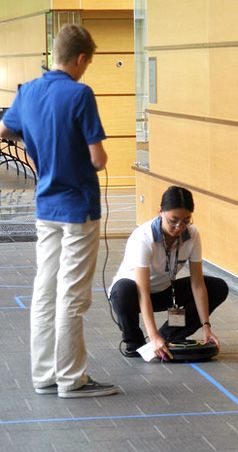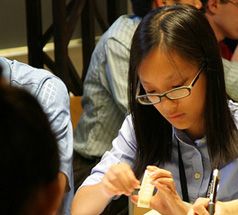It's not the typical teenage summer pastime: Forty-nine of Pennsylvania's top rising seniors journeyed from all over the State to Lehigh University for an intense and deep dive into the world of engineering, courtesy of the Pennsylvania Governor's School for Engineering and Technology (PGSE&T) held June 28-July 25.
Supported by AT&T, PPL Corporation, the Pennsylvania Department of Education, and the Team Pennsylvania Foundation, PGSE&T is a selective four-week summer residential program for talented high school students of science and mathematics. Hosted by Lehigh's P.C. Rossin College of Engineering and Applied Science, PGSE&T offers an enrichment experience in science, technology, engineering and mathematics and emphasizes cooperative learning and hands-on laboratory experiences.
"The students who participate in the Governor's Schools are the future business and technology leaders for Pennsylvania," said J. Michael Schweder, president, AT&T Mid-Atlantic, who helped kick off this year's program at Lehigh University. "The Governor's School for Engineering and Technology at Lehigh University is a great way to prepare our students for opportunities in high-demand fields. AT&T support of the Governor's Schools is an investment in the future of Pennsylvania."
"It was a constant environment of exploration and seeing what is out there," says Chris Feltner, a Pennsylvania high school senior selected for the program. "We all want to go into engineering, and some of us have an idea of what we want to go into, but beyond that it's not quite certain. Through the Governor's School, we were able to experience what engineers do."
The Art of Engineering
Throughout the program, students focused on diverse areas of engineering including robotics, materials science, bioengineering, chemical, mechanical, electrical, environmental, and civil engineering. Forget the classroom and throw out the textbooks -- the program delivered engineering via hands-on lab experiences, engaging guest speakers, group research projects, and field trips to some of the most advanced technological operations in the world.
"The Governor's School gives students a sense of what engineering is," said Bill Best, Professor of Practice in engineering who directs Lehigh's innovative IDEAS degree and served as co-academic director of PGSE&T. "I think that is very important because they realize that engineering is not just science and mathematics. Engineering is not only about equations, labs and lectures; it is a way of thinking. Engineering stands on a foundation of science and mathematics, but there is a big gap between scientific research and engineering design which can only be bridged by the art of engineering."
The magnitude of what is possible with engineering, and the scales at which engineers work, made quite an impression on the participants.
"In the Microscopy Suite at Lehigh, we worked with Scanning Electron Microscopes. I was amazed we could see individual atoms -- I never thought I would be able to do that," reports PGSE&T student Catherine Huang.
On the other side of the spectrum, the students toured Lehigh's massive Advanced Technology for Large Structural Systems (ATLSS) Engineering Research Center and took a field trip to the NASA Goddard Space Flight Center to witness the James Webb telescope under development. They even took a trip deep into the heart of the Internet, courtesy AT&T's Global Operations Center.
"We were standing in the room where they run the Internet," Feltner says. "Every phone call in AT&T's part of the world goes through that room, every website, every download, every upload, every transmission ran through that room. You could just feel the gravity of it; it just had this energy, this weight."
Back on campus, the students worked on group projects in areas such as 3D printing, cybersecurity, energy, environment/sustainability, healthcare/bioengineering, manufacturing, military technology, nanotechnology, personal electronics, and transportation/infrastructure.
"We worked in 3D modeling, and then used 3D printers to actually make the parts we designed," Chris recalls. "We then performed stress testing – it was really cool when some of them exploded. We built microfluidic devices, we did chemical engineering and created edible polymers. We programmed robots; some of us had no idea how to program at all, and in one day we figured it out together."
"What are we going to accomplish next?"
"The goal is to help students think about the advancements in technology, where things are going," says Dr. Laura Moyer of Lehigh's department of materials science and engineering, who served as co-academic advisor to PGSE&T. "They had to pick a topic and focus on technological obstacles, but also think through the ethical, legal, environmental, and social consequences of those technologies."
"They'll learn the skills necessary to be an engineer, those you can pretty much get anywhere," says Best. "What separates our Governor's School, and Lehigh in general, is that students get a broader picture of engineering. We did a lot with social implications and design issues this summer."
"That is what engineering is about, it's about empathy, it's about creativity," Feltner says. "Equations, CAD, drafting and simulations -- those things are important, and we learned those things, but they are not enough. Here we learned the most important things. We learned how to search for unconventional solutions, we learned to ask the big questions, and we learned to care about other people because that is what engineering is really about. What you're doing as an engineer is you're taking a mile in someone else's shoes, and you're saying, 'Hey, these really aren't comfortable; let me fix these for you.' It's about people, it's about having that empathy. Engineering is about looking at people's problems, society's problems, and trying to make them better because that is your passion."
"The math and science, yes that is necessary, but it is not sufficient," he continues. "You are building something new, you are extending the world to new ground, you are pushing your field to its limits. That's what engineering is -- it's about the creativity."
Feltner spoke at the closing ceremonies of the program to his peers and their families. "We may be at the end of our program," he said, "and that is sad. But it is not really the end, this is a beginning. I am super excited because I am looking out on a crowd of 48 people who are about to change the world, and I cannot wait to change it with them. So the question is not, 'Why does this have to end?' The question is, what are we going to accomplish next?"
-Amber Schrum '16 is a student-writer with the P.C. Rossin College of Engineering and Applied Science.


